United States
 After the August 18, 1976 ace murder of two United States Army officers, Captain Arthur Bonifas and Lieutenant Mark Barrett, by North Korean soldiers, in the Joint Security Area located in the North Korean Demilitarized Zone, it was decided that something had to be done about a certain poplar tree that blocked the view of UN observers, allowing them to be assaulted and killed by the North Koreans, who claimed that the tree had been planted by Kim Il-Sung. It was dubbed the Panmunjom axe murder incident, and it was infuriating to the United States.
After the August 18, 1976 ace murder of two United States Army officers, Captain Arthur Bonifas and Lieutenant Mark Barrett, by North Korean soldiers, in the Joint Security Area located in the North Korean Demilitarized Zone, it was decided that something had to be done about a certain poplar tree that blocked the view of UN observers, allowing them to be assaulted and killed by the North Koreans, who claimed that the tree had been planted by Kim Il-Sung. It was dubbed the Panmunjom axe murder incident, and it was infuriating to the United States.
Three days later, American and South Korean forces launched Operation Paul Bunyan. There was one objective to Operation Paul Bunyan…cut down the tree with a show of force to intimidate North Korea into backing down. Operation Paul Bunyan was carried out on August 21 at 07:00, three days after the killings. A convoy of 23 American and South Korean vehicles, known as “Task Force Vierra”, named after Lieutenant Colonel Victor Vierra, commander of the United States Army Support Group, drove into the JSA without any warning to the North Koreans. There was just one observation post manned at that hour. The vehicles contained two eight-man teams of military engineers from the 2nd Engineer Battalion, 2nd Infantry Division, equipped with chain-saws to cut down the tree. Accompanying these teams were two 30-man security platoons from the Joint Security Force, who were armed with pistols and axe handles. The 1st Platoon secured the northern entrance to the JSA via the Bridge of No Return, while the 2nd Platoon secured the southern edge of the area. A team from B Company, commanded by Captain Walter Seifried, activated the detonation systems for the charges on Freedom Bridge and had the 165mm main gun of the M728 combat engineer vehicle aimed mid-span to ensure that the bridge would fall should the order be given for its destruction.
B Company, supporting E Company (bridge), were building M4T6 rafts on the Imjin River should the situation require emergency evacuation by that route. An additional 64-man task force of the South Korean Special Forces accompanied them, armed with clubs and trained in Tae Kwon Do, supposedly without firearms. Once 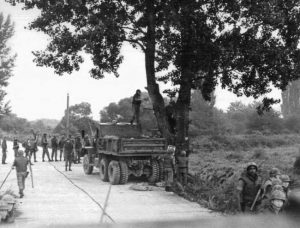 they parked their trucks near the Bridge of No Return, however, they started throwing out the sandbags that lined the truck bottoms, and handing out M16 rifles and M79 grenade launchers that had been concealed below. Several of the commandos also had M18 Claymore mines strapped to their chests with the firing mechanism in their hands, and were shouting at the North Koreans to cross the bridge. A U.S. Infantry company in 20 utility helicopters and seven Cobra attack helicopters circled behind them. Behind these helicopters, B-52 Stratofortresses, came from Guam escorted by US F-4 Phantom IIs from Kunsan Air Base and South Korean F-5 and F-86 fighters were visible flying across the sky at high altitude. At Taegu Air Base, F-111 bombers of the 366th Tactical Fighter Wing out of Mountain Home Air Force Base, were stationed, and F-4 Phantoms C and D from the 18th TFW Kadena Air Base and Clark Air Base were also deployed. The aircraft carrier USS Midway task force had also been moved to a station just offshore. Near the edges of the DMZ, many more heavily armed U.S. and South Korean infantry, artillery including the Second Battalion, 71st Air Defense Regiment armed with Improved Hawk missiles, and armor were waiting to back up the special operations team. Bases near the DMZ were prepared for demolition in case of a military response. The defense condition (DEFCON) was elevated on order of General Stilwell, as recounted in Colonel De LaTeur’s research paper later. 12,000 additional troops were ordered to Korea, including 1,800 Marines from Okinawa. During the operation, nuclear-capable strategic bombers circled over the JSA. According to an intelligence analyst monitoring the North Korea tactical radio net, the accumulation of force “blew their… minds.” Altogether, Task Force Vierra consisted of 813 men: almost all of the men of the United States Army Support Group, of which the Joint Security Force was a part; a South Korean reconnaissance company; a South Korean Special Forces company which had infiltrated the river area by the bridge the night before; and members of a reinforced composite rifle company from the 9th Infantry Regiment. In addition to this force, every UNC force in the rest of South Korea was on battle alert.
they parked their trucks near the Bridge of No Return, however, they started throwing out the sandbags that lined the truck bottoms, and handing out M16 rifles and M79 grenade launchers that had been concealed below. Several of the commandos also had M18 Claymore mines strapped to their chests with the firing mechanism in their hands, and were shouting at the North Koreans to cross the bridge. A U.S. Infantry company in 20 utility helicopters and seven Cobra attack helicopters circled behind them. Behind these helicopters, B-52 Stratofortresses, came from Guam escorted by US F-4 Phantom IIs from Kunsan Air Base and South Korean F-5 and F-86 fighters were visible flying across the sky at high altitude. At Taegu Air Base, F-111 bombers of the 366th Tactical Fighter Wing out of Mountain Home Air Force Base, were stationed, and F-4 Phantoms C and D from the 18th TFW Kadena Air Base and Clark Air Base were also deployed. The aircraft carrier USS Midway task force had also been moved to a station just offshore. Near the edges of the DMZ, many more heavily armed U.S. and South Korean infantry, artillery including the Second Battalion, 71st Air Defense Regiment armed with Improved Hawk missiles, and armor were waiting to back up the special operations team. Bases near the DMZ were prepared for demolition in case of a military response. The defense condition (DEFCON) was elevated on order of General Stilwell, as recounted in Colonel De LaTeur’s research paper later. 12,000 additional troops were ordered to Korea, including 1,800 Marines from Okinawa. During the operation, nuclear-capable strategic bombers circled over the JSA. According to an intelligence analyst monitoring the North Korea tactical radio net, the accumulation of force “blew their… minds.” Altogether, Task Force Vierra consisted of 813 men: almost all of the men of the United States Army Support Group, of which the Joint Security Force was a part; a South Korean reconnaissance company; a South Korean Special Forces company which had infiltrated the river area by the bridge the night before; and members of a reinforced composite rifle company from the 9th Infantry Regiment. In addition to this force, every UNC force in the rest of South Korea was on battle alert.

All this to cut down one tree!! My first thought on all this was…overkill, to the extreme!! That’s what I thought at first, but after researching the operation more, I realized that this was as much a show of force, as it was a way to cut down a tree that was really blocking a view that was necessary for keeping soldiers safe. North Korea needed to be shown what could come of such an attack, should it ever happen again. And it worked…North Korea accepted responsibility for the earlier killings. The incident is also known alternatively as the hatchet incident, the poplar tree incident, and the tree trimming incident. Final loss of life, two American Army officers, and one poplar tree.
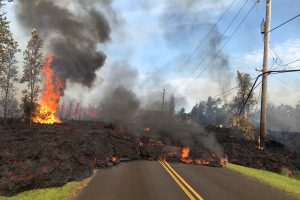 On this day, August 21, 1959, the United States as we know it was completed with the addition of the 50th State… Hawaii. It is the only state that is completely comprised of islands…volcanic islands. Hawaii has another unique feature besides being an island state. That unique feature is that it is the only state that is naturally increasing in size. Most of us immediately think of the current eruptions of Kilauea, and that is a big part of the grown of Hawaii, but it is not the only cause of the growth.
On this day, August 21, 1959, the United States as we know it was completed with the addition of the 50th State… Hawaii. It is the only state that is completely comprised of islands…volcanic islands. Hawaii has another unique feature besides being an island state. That unique feature is that it is the only state that is naturally increasing in size. Most of us immediately think of the current eruptions of Kilauea, and that is a big part of the grown of Hawaii, but it is not the only cause of the growth.
Not every addition to the Big Island involves an eruption that puts people at risk and engulfs their communities. For decades, Kilauea has experienced continuous lava flows through a vent called Pu?u ???? in Hawaii Volcanoes National Park, incrementally adding land to the southeast portion of the island. This continuous flow has added 570 acres of land to Hawaii’s Big Island since 1983, according to the U.S. Geological Survey’s most recent 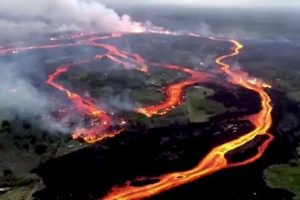 update. Unfortunately, the lava has also buried over 40 square miles of rain forest, communities, and historical sites. Hawaii is an ever-changing place, and the lava doesn’t care about such things as rain forests, communities, and historical sites.
update. Unfortunately, the lava has also buried over 40 square miles of rain forest, communities, and historical sites. Hawaii is an ever-changing place, and the lava doesn’t care about such things as rain forests, communities, and historical sites.
The current stories of the eruption of Kilauea has continued to shock the world, but in reality, Kilauea has been continuously erupting since 1983. Still, on May 3, 2018, the volcano erupted dramatically. The eruption occurred several hours after a magnitude-5.0 quake struck the Big Island. With the eruption came lava flows into residential subdivisions in the Puna district of the Big Island. This prompted mandatory evacuations of the Leilani Estates and Lanipuna Gardens subdivisions. Scientists have two theories about the formation of the Hawaiian Islands. Unlike most volcanoes, the Hawaiian chain sits squarely in the middle of the Pacific plate rather than on a tectonic boundary.
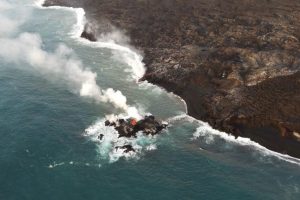
In 1963, J Tuzo Wilson proposed the “hotspot theory” to explain this unusual placement. Wilson proposed that the linear geography of the Hawaiian Islands is due to the movement of the Pacific plate over a stationary point of great heat from deep within the Earth. I have to wonder if that movement is exactly what is causing the current continuing flow of lava from Kilauea. I seems to me that it would be difficult for the lava flow to seal itself when the fault keeps breaking the seal. I could be totally wrong, or I could just be looking at this in a far too simplistic manner. Nevertheless, it seems logical to me. Or maybe that is exactly what Wilson was saying.
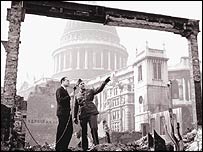 In March or 1941, the United States was largely considered neutral, so we could provide the countries, who were fighting Adolf Hitler, with war material. It was during this period of time, that the United Kingdom, an old enemy of the United States, since the United States fought against them for our independence, needed our help. Of course, we were allies by that time, and so the thought of a loan to the UK was not out o the question. The UK had been fighting against Adolf Hitler’s Germany army for a while by then, and funds were dwindling. The US loaned $4.33 billion to Britain in 1945, while Canada loaned US$1.19 billion in 1946, at a rate of 2% annual interest. It was a good deal, but in the end, the amount paid back was nearly double the amounts loaned in 1945 and 1946.
In March or 1941, the United States was largely considered neutral, so we could provide the countries, who were fighting Adolf Hitler, with war material. It was during this period of time, that the United Kingdom, an old enemy of the United States, since the United States fought against them for our independence, needed our help. Of course, we were allies by that time, and so the thought of a loan to the UK was not out o the question. The UK had been fighting against Adolf Hitler’s Germany army for a while by then, and funds were dwindling. The US loaned $4.33 billion to Britain in 1945, while Canada loaned US$1.19 billion in 1946, at a rate of 2% annual interest. It was a good deal, but in the end, the amount paid back was nearly double the amounts loaned in 1945 and 1946.
The United States was pulled into World War II shortly after, when Japan attacked Pearl Harbor. That marked to end of the program to provide military materials, because the United States was no longer considered neutral. At this point, the United States was very much needed in a very different way, and could not be neutral and be an effective help, but they also had a score to settle, and it could not be handled on the sidelines. The United States had hoped to sit this one out, but that was not to be. The Axis of Evil was winning against the Allied Nations, and they needed help, but it was the boldness of the attack on Pearl Harbor that finally awoke the sleeping giant that was the United States. The United States victory over Japan in the Battle of Midway was the turning point of the war in the Pacific. Then Germany invaded the Soviet Union. The Soviet Union defeated Germany at Stalingrad, marking the turning point of the war in Eastern Europe. As we all know, in the end the Allies were victorious in World War II.
There are still World War I debts owed to and by Britain. Since a moratorium on all debts from that conflict was agreed at the height of the Great Depression, no repayments have been made to or received from other nations since 1934. Despite the favorable rates there were six years in which Britain deferred payment because of economic or political crises. Britain settled its World War II debts to the United States and Canada when it paid the final 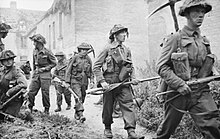 two installments in 2006. The payments of $83.25 million to the US and US$22.7 million to Canada are the last of 50 installments since 1950. Upon the final payments, the UK will have paid back a total of $7.5 billion to the US and US$2 billion to Canada. “This week we finally honor in full our commitments to the United States and Canada for the support they gave us 60 years ago,” said Treasury Minister Ed Balls at the time of those final payments. “It was vital support which helped Britain defeat Nazi Germany and secure peace and prosperity in the post-war period. We honor our commitments to them now as they honored their commitments to us all those years ago,” he added.
two installments in 2006. The payments of $83.25 million to the US and US$22.7 million to Canada are the last of 50 installments since 1950. Upon the final payments, the UK will have paid back a total of $7.5 billion to the US and US$2 billion to Canada. “This week we finally honor in full our commitments to the United States and Canada for the support they gave us 60 years ago,” said Treasury Minister Ed Balls at the time of those final payments. “It was vital support which helped Britain defeat Nazi Germany and secure peace and prosperity in the post-war period. We honor our commitments to them now as they honored their commitments to us all those years ago,” he added.
 When we think of the Old West, the Pioneer movement, the Gold Rush, and generally, the settling of the United States, our minds immediately go to the brave men who fought the Indians, ran the wagon trains, weathered the harsh winters looking for their fortunes, and fought in the wars to make this a free nation, but seldom do we think of the anonymous heroes of that time…the women. There is a saying, “Behind every great man there’s a great woman.” that saying is one reference to the many women who have set aside their own comforts to support their man in the goals and dreams he has. In many ways that saying is the picture of the Pioneer woman, but it actually leaves something out. Just because her man did not become famous, doesn’t mean that the woman was any less behind him, supporting him in all he did.
When we think of the Old West, the Pioneer movement, the Gold Rush, and generally, the settling of the United States, our minds immediately go to the brave men who fought the Indians, ran the wagon trains, weathered the harsh winters looking for their fortunes, and fought in the wars to make this a free nation, but seldom do we think of the anonymous heroes of that time…the women. There is a saying, “Behind every great man there’s a great woman.” that saying is one reference to the many women who have set aside their own comforts to support their man in the goals and dreams he has. In many ways that saying is the picture of the Pioneer woman, but it actually leaves something out. Just because her man did not become famous, doesn’t mean that the woman was any less behind him, supporting him in all he did.
Pioneer women were there, on the home front, working hard all day trying to keep their house clean in a rugged windswept frontier. Her floors were often made of dirt, and yet she swept them. The water came from a well, or a nearby creek, and she had to haul it into the house, because her man was off hunting to bring in food for the family. The house was crudely constructed with logs and often had a sod roof, and she was right there working like a man beside her husband to get that house built. She watched over the children, and kept them safe from the many perils that were a daily encounter. From snakes, to bears, to mountain lions, to Indians, she did what she needed to, even to the point of handling a gun as well as her husband did. And yet, history looked at her as the weaker part of the partnership, the one who needed to be sheltered and protected. History looked at her as if she could not 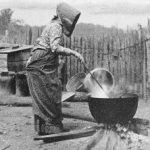 even bear to hear about certain things, because they might be too upsetting to her. In reality, they had vastly underestimated their women.
even bear to hear about certain things, because they might be too upsetting to her. In reality, they had vastly underestimated their women.
When the men got hurt, and the garden needed to be cared for, the women would till the ground…fighting with the tiller behind a horse, and winning the battle. These women took care of the house, the children, the sick or injured husband, and the garden or other crops, all without batting an eye. These women knew all about the hardships of frontier living, and when the going got tough, they didn’t turn and run back east. When the Indians attacked, they stayed and fought with their men. They could not afford to hide in a cellar, their hands were needed to hold a gun. They even faced the Indians alone, when their men were away, becoming excellent negotiators, who were able to make a trade of their wares that, in the end saved their own lives and the lives of their families. They were determined to make this new frontier work, and for the most part, they did it all without making a name for themselves. Sometimes, when we look up ancestors in historic archives, these women are either listed only as Mrs, acknowledging only the husband’s name, or they were listed only as the wife of their husband. Their true identity sometimes remains forever a mystery, and yet, they were heroes…but, they were anonymous heroes. The great men they stood behind, thereby making these men successful, may have been heroes of the frontier, and their name may have been one that every history book told us all about, 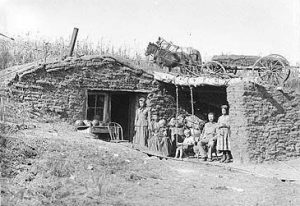 but their wives, who worked quietly beside them, remained unknown. We knew about the exploits of the men, the towns they founded, the travels they made exploring ever westward, but the women who were there with them, cooking the meals while the men talked, cleaning up afterward alone, delivering their babies often with only the help of their husband, carrying a baby, while weeding a garden, and feeding their family before themselves, going hungry, if necessary, to make sure the family was taken care of…these women rarely made the history books. Their job must have seemed to mundane to be considered adventurous, but without their contribution, this nation would not have become the great Republic that it is.
but their wives, who worked quietly beside them, remained unknown. We knew about the exploits of the men, the towns they founded, the travels they made exploring ever westward, but the women who were there with them, cooking the meals while the men talked, cleaning up afterward alone, delivering their babies often with only the help of their husband, carrying a baby, while weeding a garden, and feeding their family before themselves, going hungry, if necessary, to make sure the family was taken care of…these women rarely made the history books. Their job must have seemed to mundane to be considered adventurous, but without their contribution, this nation would not have become the great Republic that it is.
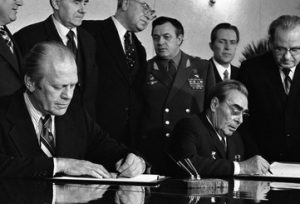 During the Cold War, the threat of a nuclear attack was the biggest concern in world relationships. During the late 1960s, the United States learned that the Soviet Union had embarked upon a massive Intercontinental Ballistic Missile (ICBM) buildup designed to catch up with the United States. The situation seemed to be heating up, because the Soviet Union seemed far more likely to use such weapons, so it looked like it was time to take action. In January 1967, President Lyndon Johnson announced that the Soviet Union had begun to construct a limited Anti-Ballistic Missile (ABM) defense system around Moscow. The development of an ABM system could allow one side to launch a first strike and then prevent the other from retaliating by shooting down incoming missiles. That was completely unacceptable.
During the Cold War, the threat of a nuclear attack was the biggest concern in world relationships. During the late 1960s, the United States learned that the Soviet Union had embarked upon a massive Intercontinental Ballistic Missile (ICBM) buildup designed to catch up with the United States. The situation seemed to be heating up, because the Soviet Union seemed far more likely to use such weapons, so it looked like it was time to take action. In January 1967, President Lyndon Johnson announced that the Soviet Union had begun to construct a limited Anti-Ballistic Missile (ABM) defense system around Moscow. The development of an ABM system could allow one side to launch a first strike and then prevent the other from retaliating by shooting down incoming missiles. That was completely unacceptable.
President Johnson decided to call for strategic arms limitations talks…nicknamed SALT, and in 1967, he and Soviet Premier Alexei Kosygin met at Glassboro State College in New Jersey. Johnson said they must gain “control of the ABM race,” and Secretary of Defense Robert McNamara argued that the more each reacted to the other’s escalation, the more they had chosen “an insane road to follow.” Completely abolishing nuclear weapons would be impossible, but limiting the development of both offensive and defensive strategic systems could be done, and it might help stabilize relations between the 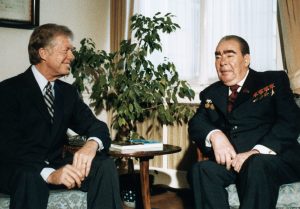 United States and the Soviet Union. The resulting SALT-I treaty was signed in 1972. The 1972 treaty limited a wide variety of nuclear weapons, but it did not address many of the other issues, so shortly after the SALT-I treaty was ratified, talks between the United States and the Soviet Union began anew. Those talks failed to achieve any new breakthroughs. By 1979, both the United States and the Soviet Union were eager to try again. For the United States, the thought that the Soviets were leaping ahead in the arms race was the primary motivator. For the Soviet Union, the increasingly close relationship between America and communist China was a cause for growing concern.
United States and the Soviet Union. The resulting SALT-I treaty was signed in 1972. The 1972 treaty limited a wide variety of nuclear weapons, but it did not address many of the other issues, so shortly after the SALT-I treaty was ratified, talks between the United States and the Soviet Union began anew. Those talks failed to achieve any new breakthroughs. By 1979, both the United States and the Soviet Union were eager to try again. For the United States, the thought that the Soviets were leaping ahead in the arms race was the primary motivator. For the Soviet Union, the increasingly close relationship between America and communist China was a cause for growing concern.
The SALT-II agreement was the result of those many nagging issues that were left over from the successful SALT-I treaty of 1972, but it had problems of its own. The treaty basically established numerical equality between the two nations in terms of nuclear weapons delivery systems. It also limited the number of MIRV missiles (missiles with multiple, independent nuclear warheads). In truth, the treaty did little or nothing to stop, or even substantially slow down, the arms race, and it met with unrelenting criticism in the United States. The treaty was thought to be a “sellout” to the Soviets. People believed that it would leave America virtually defenseless against a whole range of new weapons not mentioned in the agreement. Even supporters of arms control were less than enthusiastic about the treaty, since it did little to actually control arms. Nevertheless, during a summit meeting in Vienna, President Jimmy Carter and Soviet leader Leonid Brezhnev signed the 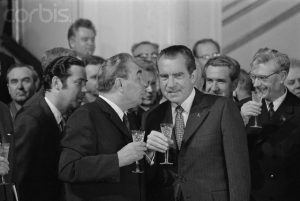 SALT-II agreement dealing with limitations and guidelines for nuclear weapons, on June 18, 1979. The treaty, would never formally go into effect, and it proved to be one of the most controversial agreements between the United States and the Soviet Union of the entire Cold War. Debate over SALT-II in the U.S. Congress continued for months. Then in December 1979, the Soviets invaded Afghanistan. The Soviet attack effectively killed any chance of SALT-II being passed, and Carter ensured this by withdrawing the treaty from the Senate in January 1980. SALT-II thus remained signed, but was never ratified. During the 1980s, both nations agreed to respect the agreement until such time as new arms negotiations could take place.
SALT-II agreement dealing with limitations and guidelines for nuclear weapons, on June 18, 1979. The treaty, would never formally go into effect, and it proved to be one of the most controversial agreements between the United States and the Soviet Union of the entire Cold War. Debate over SALT-II in the U.S. Congress continued for months. Then in December 1979, the Soviets invaded Afghanistan. The Soviet attack effectively killed any chance of SALT-II being passed, and Carter ensured this by withdrawing the treaty from the Senate in January 1980. SALT-II thus remained signed, but was never ratified. During the 1980s, both nations agreed to respect the agreement until such time as new arms negotiations could take place.
 From November 1, 1955 until April 30, 1975, the Vietnam war raged. The United States entered the war on March 8, 1965. It was an unpopular war from the start. Those who protested US involvement felt like it wasn’t our war and we shouldn’t be there. Be that as it may, we were there, and for the time being, we weren’t going anywhere. The war was a long one, but on April 30, 1975, it came to an abrupt end, when Saigon fell.
From November 1, 1955 until April 30, 1975, the Vietnam war raged. The United States entered the war on March 8, 1965. It was an unpopular war from the start. Those who protested US involvement felt like it wasn’t our war and we shouldn’t be there. Be that as it may, we were there, and for the time being, we weren’t going anywhere. The war was a long one, but on April 30, 1975, it came to an abrupt end, when Saigon fell.
At dawn that spring morning, communist forces moved into Saigon, where they received only sporadic resistance. The South Vietnamese forces had collapsed under the rapid advancement of the North Vietnamese. The most recent fighting had begun in December 1974. That was when the North Vietnamese launched a major attack against the lightly defended province of Phuoc Long, which was located due north of Saigon along the Cambodian border, overrunning the provincial capital at Phuoc Binh on January 6, 1975. Despite previous promises, from President Nixon, to provide aid if the communists attacked Saigon, the United States did nothing. The problem…Nixon had resigned from office and his successor, Gerald Ford, was unable to convince a hostile Congress to keep Nixon’s earlier promises to rescue Saigon from communist takeover. The United States had its own set of tumultuous circumstances to deal with at that time.
The lack of response from the United States emboldened the North Vietnamese, who launched a new campaign 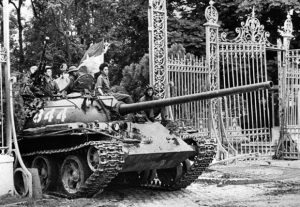 in March 1975. The South Vietnamese forces fell back in total chaos, and once again, the United States did nothing. The South Vietnamese abandoned Pleiku and Kontum in the Highlands with little to no fighting. Then Quang Tri, Hue, and Da Nang fell to the communist onslaught. The North Vietnamese continued to attack south along the coast toward Saigon, defeating the South Vietnamese forces at each encounter.
in March 1975. The South Vietnamese forces fell back in total chaos, and once again, the United States did nothing. The South Vietnamese abandoned Pleiku and Kontum in the Highlands with little to no fighting. Then Quang Tri, Hue, and Da Nang fell to the communist onslaught. The North Vietnamese continued to attack south along the coast toward Saigon, defeating the South Vietnamese forces at each encounter.
The South Vietnamese 18th Division had fought a valiant battle at Xuan Loc, just to the east of Saigon, destroying three North Vietnamese divisions in the process. They were the only division that seemed capable of continuing the fight. That was to be the last battle in the defense of the Republic of South Vietnam. The South Vietnamese forces held out against the attackers until they ran out of tactical air support and weapons, finally abandoning Xuan Loc to the communists on April 21, 1975.
Having crushed the last major organized opposition before Saigon, the North Vietnamese got into position for the final assault. In Saigon, South Vietnamese President Nguyen Van Thieu resigned and transferred authority to Vice President Tran Van Huong before fleeing the city on April 25. By April 27, the North Vietnamese had  completely encircled Saigon and began to maneuver for a complete takeover. When they attacked at dawn on April 30, they met little resistance. North Vietnamese tanks crashed through the gates of the Presidential Palace and the war came to an end. North Vietnamese Colonel Bui Tin accepted the surrender from General Duong Van Minh, who had taken over after Tran Van Huong and had only spent only one day in power. Tin explained to Minh, “You have nothing to fear. Between Vietnamese there are no victors and no vanquished. Only the Americans have been beaten. If you are patriots, consider this a moment of joy. The war for our country is over.” Of course, this also meant that Vietnam would be a Communist country, like it or not.
completely encircled Saigon and began to maneuver for a complete takeover. When they attacked at dawn on April 30, they met little resistance. North Vietnamese tanks crashed through the gates of the Presidential Palace and the war came to an end. North Vietnamese Colonel Bui Tin accepted the surrender from General Duong Van Minh, who had taken over after Tran Van Huong and had only spent only one day in power. Tin explained to Minh, “You have nothing to fear. Between Vietnamese there are no victors and no vanquished. Only the Americans have been beaten. If you are patriots, consider this a moment of joy. The war for our country is over.” Of course, this also meant that Vietnam would be a Communist country, like it or not.
 For many years, I have admired Albert Einstein. His mind and his level of intelligence intrigued me, as did his quirkiness. When you think of a genius, your mind automatically produces a picture of a very organized person, who is able to handle any situation, but even geniuses have their issues with things. One well know “weakness” for Einstein was the fact that if something can be written down, it need not take up space in his brain. His brain was very full after all, and clutter was always an issue. That said, if he couldn’t find his train ticket…for the train he took every day from home to work and back…he didn’t know at which stop to get off, because he relied on his ticket to tell him that. I don’t think most of us could even begin to filter our brain in such a way…but Einstein could, and did.
For many years, I have admired Albert Einstein. His mind and his level of intelligence intrigued me, as did his quirkiness. When you think of a genius, your mind automatically produces a picture of a very organized person, who is able to handle any situation, but even geniuses have their issues with things. One well know “weakness” for Einstein was the fact that if something can be written down, it need not take up space in his brain. His brain was very full after all, and clutter was always an issue. That said, if he couldn’t find his train ticket…for the train he took every day from home to work and back…he didn’t know at which stop to get off, because he relied on his ticket to tell him that. I don’t think most of us could even begin to filter our brain in such a way…but Einstein could, and did.
Einstein was a gifted scientist and mathematician. He was most famous for his theory of relativity and the resulting formula relating mass and energy…E = MC². He was the winner of 1921 Nobel Prize in physics for his work on the photoelectric effect, which is also known as the Hertz effect. Einstein was born in Ulm, in the Kingdom of Württemberg in the German Empire, on March 14, 1879. His parents were Hermann Einstein, a salesman and engineer, and Pauline Koch. He didn’t feel the need to celebrate his birthday,saying “It is a known fact that I was born, and that is all that is necessary.” Friends, colleagues and complete strangers still felt the need to send telegrams, cards, letters, gifts, and an elaborate birthday cake.
Being a Jewish man, circumstances in Germany became life threatening for Einstein in the early 1930s, so early in 1933, while on a trip to the United States, he knew he could not go home again, so he moved permanently  to the United States, and worked at Princeton University…a career that would take him to the end of his life on April 18, 1955. Einstein could have been saved, but when he was asked if he wanted to undergo surgery, he refused, saying, “I want to go when I want to go. It is tasteless to prolong life artificially. I have done my share; it is time to go. I will do it elegantly.” After an autopsy, Einstein’s body was cremated and his ashes spread in an undisclosed location.
to the United States, and worked at Princeton University…a career that would take him to the end of his life on April 18, 1955. Einstein could have been saved, but when he was asked if he wanted to undergo surgery, he refused, saying, “I want to go when I want to go. It is tasteless to prolong life artificially. I have done my share; it is time to go. I will do it elegantly.” After an autopsy, Einstein’s body was cremated and his ashes spread in an undisclosed location.
After his passing, another of the multiple quirky aspects of Einstein’s personality came to light when LIFE magazine wrote about a famous picture taken in Albert Einstein’s Princeton office. Einstein’s desk was just as he left it. Here, the picture says, is where Einstein worked, dreamed, lived his singular, principled life to its fullest. “When I was young, all I wanted and expected from life was to sit quietly in some corner doing my work without the public paying attention to me,” said Einstein after being honored at a social function. “And now see what has become of me.”
When I look and Einstein’s desk, it takes me back to the many times my own desk has looked exactly like that. It is another way that the famed scientific and mathematical genius and I are alike. Now, I do not claim to have the IQ of this man, but we do have a few things in common, and the ability to work on top of a stack of papers seems to be one of them. Maybe that and the ability to somewhat filter things out of my mind if they are stored in my phone which could be the same thing as filtering because I have it written down. And because of my shy side, I suppose I can understand his concern over public attention, and yet knowing that sometimes it can’t be helped. When I look at his desk, I can see a man whose mind was fill with many thoughts, making it easy to 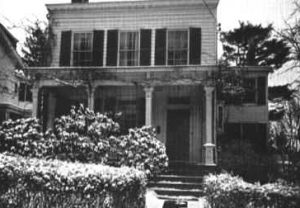 lose himself in his thoughts to the point of seeming to ignore those around him. Those who met Einstein recalled his human side. He “walked to work or rode the bus in bad weather; visited the neighbors’ newborn kittens; greeted carolers on winter nights; refused to update his eyeglass prescription; and declined to wear socks because they would get holes in them. But he didn’t seem to mind fuzzy slippers!” He was his own man with his own ideas, and if those ideas didn’t make sense to those around him, it was simply not his problem. On April 18, 1955, Albert Einstein died soon after a blood vessel burst near his heart. The world mourned Einstein’s death, but true to form, at his request, his office and house were not turned into memorials.
lose himself in his thoughts to the point of seeming to ignore those around him. Those who met Einstein recalled his human side. He “walked to work or rode the bus in bad weather; visited the neighbors’ newborn kittens; greeted carolers on winter nights; refused to update his eyeglass prescription; and declined to wear socks because they would get holes in them. But he didn’t seem to mind fuzzy slippers!” He was his own man with his own ideas, and if those ideas didn’t make sense to those around him, it was simply not his problem. On April 18, 1955, Albert Einstein died soon after a blood vessel burst near his heart. The world mourned Einstein’s death, but true to form, at his request, his office and house were not turned into memorials.
 With new technology, always comes some risk of failure. Sometimes, the the failure doesn’t hurt anything, but other times, it can be deadly. In the world of submarines, the atomic submarine was the latest thing in the 1960s. The USS Thresher was launched on July 9, 1960, from Portsmouth Naval Yard in New Hampshire. It was built with the latest technology, and was the first submarine assembled as part of a new class that could run more quietly and dive deeper than any that had come before it. The designers and the Navy expected great things from Thresher, and initially, the submarine met their expectations.
With new technology, always comes some risk of failure. Sometimes, the the failure doesn’t hurt anything, but other times, it can be deadly. In the world of submarines, the atomic submarine was the latest thing in the 1960s. The USS Thresher was launched on July 9, 1960, from Portsmouth Naval Yard in New Hampshire. It was built with the latest technology, and was the first submarine assembled as part of a new class that could run more quietly and dive deeper than any that had come before it. The designers and the Navy expected great things from Thresher, and initially, the submarine met their expectations.
Then on April 10, 1963, at just before 8am, the Thresher was conducting drills off the coast of Cape Cod. At 9:13am, the USS Skylark, another ship participating in the drills, received a communication from the Thresher that the sub was experiencing 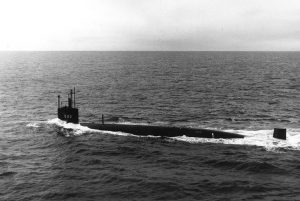 minor problems. Unfortunately, the minor problems turned into a very major problem…almost instantly. Other attempted communications with Thresher failed and, only five minutes later, sonar images showed the Thresher breaking apart as it fell to the bottom of the sea, 300 miles off the coast of New England. Sixteen officers, 96 sailors and 17 civilians were on board. All were killed.
minor problems. Unfortunately, the minor problems turned into a very major problem…almost instantly. Other attempted communications with Thresher failed and, only five minutes later, sonar images showed the Thresher breaking apart as it fell to the bottom of the sea, 300 miles off the coast of New England. Sixteen officers, 96 sailors and 17 civilians were on board. All were killed.
On April 12, President John F. Kennedy ordered that flags across the country be flown at half-staff to commemorate the lives lost in this disaster. A subsequent investigation revealed that a leak in a silver-brazed joint in the engine room had caused a short circuit in critical electrical systems. The problems quickly spread, making the equipment needed to bring the Thresher to the surface inoperable. The submarine went into a freefall to the bottom. There was no time to do anything to stop it or find a way of escape…if one existed.
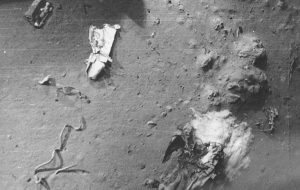
The disaster forced improvements in the design and quality control of submarines. Twenty-five years later, in 1988, Vice Admiral Bruce Demars, the Navy’s chief submarine officer, said “The loss of Thresher initiated fundamental changes in the way we do business–changes in design, construction, inspections, safety checks, tests, and more. We have not forgotten the lessons learned. It’s a much safer submarine force today.” I don’t think there was necessarily anything that was done so wrong that it could have prevented what happened, but I could be wrong. Obviously, there is always room for improvement in any design, but unfortunately, sometimes the only way to know that an improvement is needed, is to have a disaster strike.
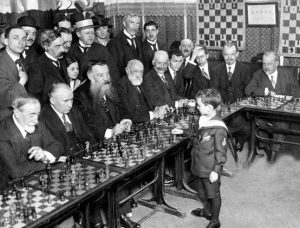 Mastery knows no age. Genius can occur in anyone, and of course, always presents itself when a child is very young. In 1920, one such genius, Samuel Reshevsky was busy mastering chess masters in France. Reshevsky learned chess when he was just 4 years old. He became known as a child chess prodigy and was playing simultaneous games of chess against adults when he was 6 years of age. At age 8 he was playing chess against strong players. Following the events of World War 1, Reshevsky immigrated to the United States. As a 9 year old, his first American simultaneous exhibition was with 20 officers and cadets at the Military Academy at West Point. He won 19 games and drew one. He toured the country and played over 1,500 games as a 9 year old in simultaneous exhibitions and only lost 8 games. In his early years he did not go to school and his parents ended up in Manhattan Children’s Court on charges of improper guardianship. In reality, little Samuel probably could have taught the teachers, so missing some of his education was not detrimental to him in any way.
Mastery knows no age. Genius can occur in anyone, and of course, always presents itself when a child is very young. In 1920, one such genius, Samuel Reshevsky was busy mastering chess masters in France. Reshevsky learned chess when he was just 4 years old. He became known as a child chess prodigy and was playing simultaneous games of chess against adults when he was 6 years of age. At age 8 he was playing chess against strong players. Following the events of World War 1, Reshevsky immigrated to the United States. As a 9 year old, his first American simultaneous exhibition was with 20 officers and cadets at the Military Academy at West Point. He won 19 games and drew one. He toured the country and played over 1,500 games as a 9 year old in simultaneous exhibitions and only lost 8 games. In his early years he did not go to school and his parents ended up in Manhattan Children’s Court on charges of improper guardianship. In reality, little Samuel probably could have taught the teachers, so missing some of his education was not detrimental to him in any way.
Reshevsky was a tough and forceful player who was superb at positional play, but could also play brilliant  tactical chess when warranted. He often used huge amounts of time in the opening, a dangerous tactic which sometimes forced him to play the rest of the game in a very short amount of time. That sometimes unsettled Reshevsky’s opponents, but at other times resulted in blunders on his part. Reshevsky’s inadequate study of the opening and his related tendency to fall into time-pressure may have been the reasons that, despite his great talent, he never became world champion; he himself acknowledged this in his book on chess upsets.
tactical chess when warranted. He often used huge amounts of time in the opening, a dangerous tactic which sometimes forced him to play the rest of the game in a very short amount of time. That sometimes unsettled Reshevsky’s opponents, but at other times resulted in blunders on his part. Reshevsky’s inadequate study of the opening and his related tendency to fall into time-pressure may have been the reasons that, despite his great talent, he never became world champion; he himself acknowledged this in his book on chess upsets.
Reshevsky never became a truly professional chess player. He gave up competitive chess for seven years, from 1924 to 1931, to complete his secondary education. He graduated from the University of Chicago in 1934 with a degree in accounting, and supported himself and his family by working as an accountant. Not everyone could leave off and then pick up their education and never miss a beat. Of course, when you have genius level intelligence, I guess that isn’t a problem.
 During the Vietnam War, as in any war, children can become displaced because of the loss of their parents. The country has already lost so many people, and often there is no one to take these little orphans, so they often end up in an orphanage, waiting for someone to come along and adopt them. Many times, they live their entire childhood in that orphanage. For a country that has already be devastated by war, the cost of raising these children is detrimental. Such was the case for orphaned children from the Vietnam War. Then the United States made the decision to airlift these children to the United States to be adopted by American families who were waiting for children. The plan was dubbed Operation Baby Lift, and while it would end up being successful, it got of the a sad and rocky start on April 4, 1975, when the first plane crashed shortly after taking off from Tan Son Nhut airbase in Saigon. On board were more than 300 passengers. Of those, 138 passengers, mostly children were killed.
During the Vietnam War, as in any war, children can become displaced because of the loss of their parents. The country has already lost so many people, and often there is no one to take these little orphans, so they often end up in an orphanage, waiting for someone to come along and adopt them. Many times, they live their entire childhood in that orphanage. For a country that has already be devastated by war, the cost of raising these children is detrimental. Such was the case for orphaned children from the Vietnam War. Then the United States made the decision to airlift these children to the United States to be adopted by American families who were waiting for children. The plan was dubbed Operation Baby Lift, and while it would end up being successful, it got of the a sad and rocky start on April 4, 1975, when the first plane crashed shortly after taking off from Tan Son Nhut airbase in Saigon. On board were more than 300 passengers. Of those, 138 passengers, mostly children were killed.
Captain Dennis “Bud” Traynor was the captain on the plane. Many of the 138 passengers were children, and  many of them were under age 2 and so small, they had to be carried onto the plane. “We bucket-brigade-loaded the children right up the stairs into the airplane,” Traynor remembers. The flight began normally, but shortly into the flight, when the plane’s cargo doors malfunctioned they blew out, taking with them a chunk of the tail. There was a rapid decompression inside the aircraft, causing the pilot, Traynor, to crash land the C-5 cargo plane into a nearby rice paddy. Traynor managed to stabilize the plane and turn it back toward Vietnam. After that, his only option was a crash landing. The impact was fierce. “It cut all control cables to the tail,” explains Traynor. “So I’m pulling and pulling and pulling, and my nose is going down further and further and we’re going faster and faster and faster, and I can’t figure this out. We came to a stop and I thought to myself ‘I’m alive,'” he says. “And so I undid my lap belt, fell to the ceiling, rolled open the side window, and stepped out and saw the wings burning. And I thought, ‘Oh no, that’s the rest of the airplane.'” Out of the more than 300 people on board, the death toll included 78 children and about 50 adults, including Air Force personnel. More than 170 survived.
many of them were under age 2 and so small, they had to be carried onto the plane. “We bucket-brigade-loaded the children right up the stairs into the airplane,” Traynor remembers. The flight began normally, but shortly into the flight, when the plane’s cargo doors malfunctioned they blew out, taking with them a chunk of the tail. There was a rapid decompression inside the aircraft, causing the pilot, Traynor, to crash land the C-5 cargo plane into a nearby rice paddy. Traynor managed to stabilize the plane and turn it back toward Vietnam. After that, his only option was a crash landing. The impact was fierce. “It cut all control cables to the tail,” explains Traynor. “So I’m pulling and pulling and pulling, and my nose is going down further and further and we’re going faster and faster and faster, and I can’t figure this out. We came to a stop and I thought to myself ‘I’m alive,'” he says. “And so I undid my lap belt, fell to the ceiling, rolled open the side window, and stepped out and saw the wings burning. And I thought, ‘Oh no, that’s the rest of the airplane.'” Out of the more than 300 people on board, the death toll included 78 children and about 50 adults, including Air Force personnel. More than 170 survived.
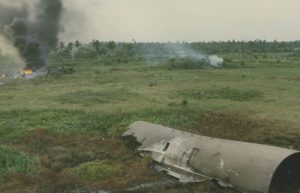 While it was an unusual plan, hatched in the midst of the political fallout, the United States government announced the plan to get thousands of displaced Vietnamese children out of the country. President Ford directed that money from a special foreign aid children’s fund be made available to fly 2,000 South Vietnamese orphans to the United States. Operation Baby Lift lasted for just ten days. Baby Lift was carried out during the final, desperate phase of the war, as North Vietnamese forces closed in on Saigon. Although this first flight ended in tragedy, the rest of the flights were completed safely, and Baby Lift aircraft brought orphans across the Pacific until the mission’s conclusion on April 14, just 16 days before the fall of Saigon and the end of the war.
While it was an unusual plan, hatched in the midst of the political fallout, the United States government announced the plan to get thousands of displaced Vietnamese children out of the country. President Ford directed that money from a special foreign aid children’s fund be made available to fly 2,000 South Vietnamese orphans to the United States. Operation Baby Lift lasted for just ten days. Baby Lift was carried out during the final, desperate phase of the war, as North Vietnamese forces closed in on Saigon. Although this first flight ended in tragedy, the rest of the flights were completed safely, and Baby Lift aircraft brought orphans across the Pacific until the mission’s conclusion on April 14, just 16 days before the fall of Saigon and the end of the war.

